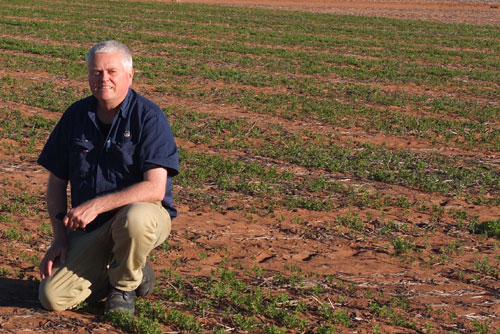Australia
January 29, 2020

Department of Primary Industries and Regional Development research scientist Mark Seymour, pictured in a lentil variety trial plot at Merredin in July 2019, will profile some exciting new pulse varieties at the 2020 GRDC Grains Research Update in Perth next month.
A range of new pulse varieties that show potential for inclusion in Western Australian farming systems will be scrutinised at the State’s premier grains conference next month.
The analysis by the Department of Primary Industries and Regional Development of several recently released faba bean, chickpea and lentil varieties will be a feature of the 2020 Grains Research and Development Corporation (GRDC) Grains Research Updates, Perth.
There has been renewed interest in pulses in recent years, buoyed by improved new cultivars and agronomy, backed by positive trial results and market conditions.
Department research scientist Mark Seymour said two new faba bean varieties, PBA Bendoc and PBA Amberley, are likely to prove very useful to WA growers.
“PBA Bendoc is Australia’s first imidazolinone tolerant faba bean, which will provide more in-crop broadleaf weed control options,” Mr Seymour said.
“PBA Amberley has the highest rated resistance to chocolate spot and has shown to be less prone to necking (bending over), making it suitable to high yielding environments.
“With similar to higher yields to PBA Samira, these varieties are likely to be popular in the Albany Port Zone, spurred on by current prices of more than $500 per tonne.”
Interest in lentils continues to grow beyond the traditional Esperance Port Zone into northern regions, although below average rainfall significantly affected crop performance in 2019.
“The red lentil PBA Highland XT, released in 2019, is an imidazolinone tolerant variety, which will be useful to growers with lighter textured soils, where the use of Group C herbicides can be a challenge,” Mr Seymour said.
“It yields higher than PBA Hallmark XT and PBA Bolt in WA, has improved ascochyta resistance and flowers earlier than other XT varieties.”
A new desi chickpea, CICA 1521, is set to be released in 2020 and has shown significant potential in WA.
“Trials to date indicate CICA 1521 yields are equal to or higher than PBA Striker and Neelam, Genesis 836 and Gen 090,” Mr Seymour said.
“CICA 1521 has a taller canopy than other chickpeas currently available in WA, which should make it easier to harvest, while the early to mid-flowering variety has a similar ascochyta rating to PBA Striker and medium seed size.
“The new variety is expected to be released in spring 2020 and won’t be available to growers until 2021 so, in the meantime, growers of desi lentils are encouraged to seek out either PBA Striker or Neelam.”
The department will continue field trials in 2020 across many sites in the grainbelt, as part of a three-and-a-half year project, with GRDC co-investment, to support the adoption of high value pulses in WA.
Mr Seymour said the first year of the project in 2019 had shown encouraging results for pulses, despite a well below average rainfall season.
“Many of these new varieties, when combined with improved agronomy and new generation weed and disease control, offer a unique opportunity to overcome of the barriers to the adoption of pulses in WA,” he said.
“Profitable pulses can play an important role in crop rotations, as a break crop with nitrogen fixing characteristics, which can also generate broad farming systems benefits.”
The 2020 GRDC Grains Research Update will be held in Perth on Monday 24 and Tuesday 25 February, while Regional Updates are scheduled in the weeks following. For details visit the GRDC Updates and events page.